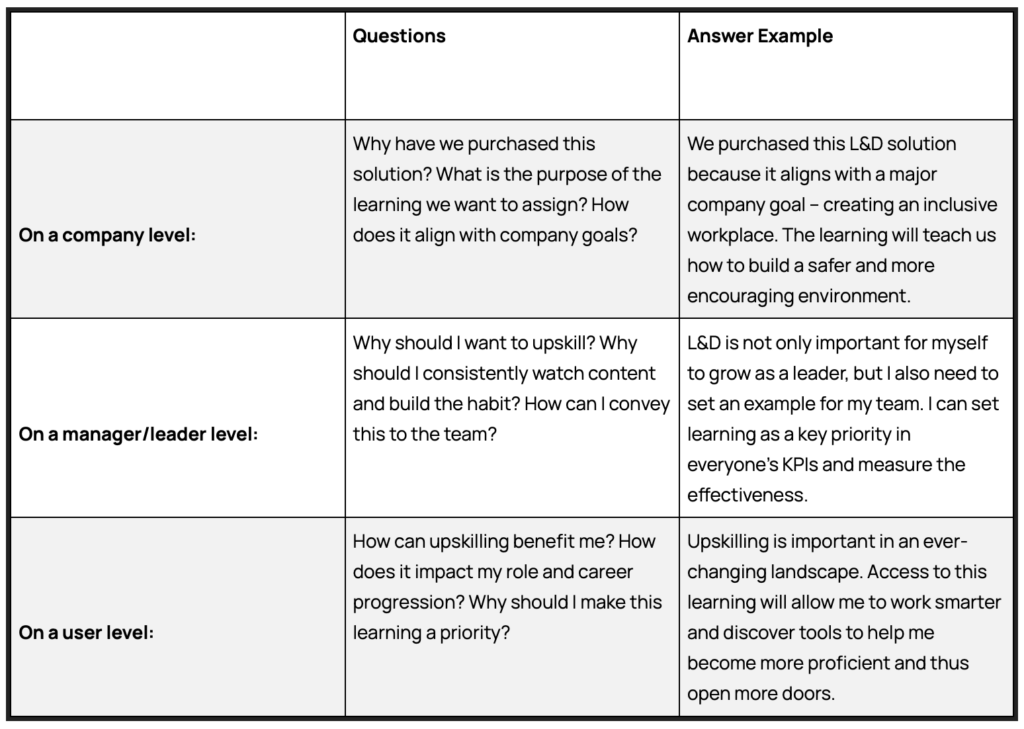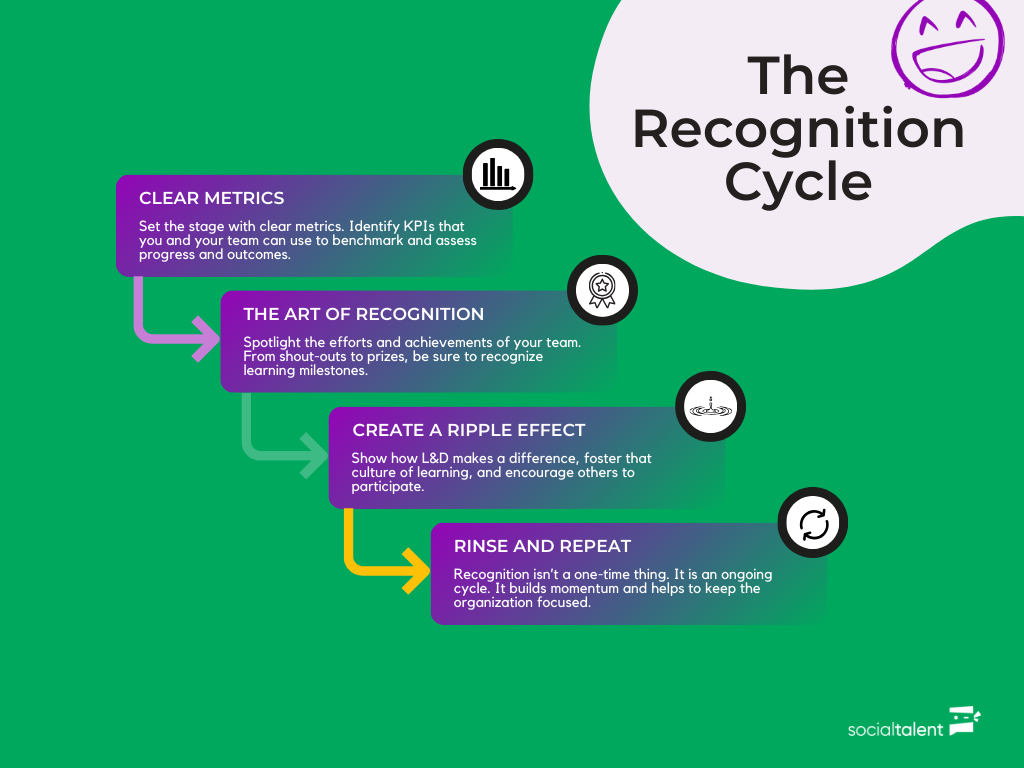The Four Keys to a Successful L&D Rollout
Change seems to be the only constant in today’s workplace, and the need for continuous learning and development has never been more critical. Yet, amidst the hustle and bustle of daily operations, rolling out an effective and engaging L&D solution can seem like a Herculean task.
When looking to introduce a learning solution into your workplace, we have to move beyond the traditional, often siloed, approach to L&D and embrace a more holistic, integrated, and appealing strategy that not only aligns with your organizational goals but also resonates with your workforce.
This isn’t just about ticking boxes or fulfilling compliance requirements; it’s about fostering a culture of curiosity, agility, and continuous improvement that propels your organization and its people toward excellence!
In this article, we’ll navigate the ins and outs of successfully rolling out an L&D solution, focusing on strategic alignment, stakeholder engagement, iteration, and recognition. From defining clear objectives and engaging stakeholders early to measuring success, we’ll delve into actionable strategies and insights that will help you not just launch but sustain a successful learning and development initiative.

1. Understanding the ‘Why’
Understanding the ‘why’ behind launching an L&D program is fundamental. It is a step in proceedings that cannot be skipped – but, in our experience, is something that many companies do not spend enough time on. As stated by McKinsey, only 40% of companies say that their learning strategy is aligned with business goals.
It’s a ‘running before you can walk’ scenario. In the excitement or immediacy of rolling out training, it can be easy to forget what the north-star for your organization and teams is. Afterall, the why informs everything you do throughout the rollout, and beyond, so it’s worth digging into.
SocialTalent’s Customer Success Manager, Aobhe Smyth, looks at this through three lenses when she’s working with our customers:

Remember – millions saw the apple fall, but only Newton sought to ask why. Asking and understanding your why can be the difference between your learning program blossoming into a true culture or withering into oblivion. Don’t. Forget. Your. Why!
2. Engage Stakeholders Early
Imagine embarking on a new journey and not consulting the map app on your phone. You blindly set off in a direction you think might be correct, but fail to make any real progress. That’s what rolling out an L&D solution without engaging your stakeholders would be like!
- Identifying Your Champions: Assemble your dream team! This comprises not just leadership but also department heads, managers, and, importantly, the potential users of the L&D solution that will be able to engage and encourage its use. Think of them as co-pilots, each bringing a unique perspective to the table, ensuring your L&D solution rollout is well-rounded and comprehensive.
- Crafting Your Communication Blueprint: With your team on board, the next step is developing a robust communication plan. Utilize a variety of channels, from emails and newsletters to town halls and informal coffee chats. The goal? To inform, engage, and excite your stakeholders about the journey ahead. This communication should not be a one-way street – encourage feedback and ideas, create a buzz around the L&D initiative even before its official launch.
- Turning Skeptics into Champions: It’s natural to encounter a bit of turbulence in the form of skepticism or resistance. Here’s where the art of persuasion, backed by clear, data-driven benefits of the L&D solution, comes into play. Share success stories, potential outcomes, and how this solution aligns with the individual and organizational growth objectives. Transforming skeptics into champions is about showing them that ever-crucial why behind the initiative and how they play a critical role in its success.
- Keeping the Conversation Going: Lastly, remember that early engagement is just the beginning. Keep the conversation going through regular updates, feedback sessions, and give opportunities for stakeholders to voice their thoughts and concerns. This ongoing dialogue ensures that your L&D solution remains relevant, responsive, and aligned with your organization’s evolving needs.
By placing stakeholder engagement at the heart of your L&D roll-out, you’re not just ensuring a smoother launch; you’re fostering a culture of learning that’s embraced and championed across all levels of the organization.
3. Pilot, Provide Support, and Iterate
Successfully implementing a learning and development program is not a straight line but a cycle of support, experimentation, and refinement.
Step One: Ensure Support
Before learners even log in, ensure they know help is at hand. Start with comprehensive training for managers, equipping them with the knowledge and tools needed to champion the L&D solution within their teams. They should be adept at encouraging learning engagement and tracking progress, acting as both mentors and motivators.
Coinciding with this, it’s also a good idea to develop a suite of resources for users, ranging from FAQs and how-to guides to interactive tutorials and live support options. The goal is to preempt questions and concerns, making the transition to the new L&D solution as seamless as possible.
Step Two: Pilot the Program
Choosing a select group of users, launch a pilot program to put your learning solution through its paces. This “test flight” is crucial for gauging effectiveness, user engagement, and overall impact on learning outcomes. Treat feedback from this phase as gold dust, providing invaluable insights into what works, what doesn’t, and what could be improved. The pilot also allows you to identify any user experience issues, ensuring these are ironed out before a full-scale roll-out. Think of it as fine-tuning your instrument before the concert begins so every note resonates with clarity and purpose!
Step Three: Iteration
Now, armed with feedback and firsthand observations from the pilot, enter the iteration phase. This is where the magic of continuous improvement comes into play. Use the insights gathered to refine content, adjust learning paths, and enhance user experience. It’s also an opportunity to revisit and realign the L&D solution with your organization’s evolving goals and needs. Establish a continuous feedback loop, encouraging ongoing input from all user groups. This not only helps in making immediate improvements but also fosters a culture of openness and collaboration, where everyone feels invested in the success of the learning initiative.
Learn more: Coaching the Coaches – A Manager’s Role in Learning and Development
4. Celebrate Success
In the journey of learning and development, recognizing and celebrating success is not just a nice-to-have; it’s an essential and ongoing necessity. It’s about acknowledging progress, valuing achievement, and, most importantly, inspiring continued growth and development. This chart explains what we mean:

Each stage is important when establishing a new learning program:
Clear Metrics: Success, in the context of an L&D initiative, should be tangible and measurable. Start by defining clear metrics and key performance indicators (KPIs) such as engagement rates, completion rates, learning outcomes, and their impact on performance. These metrics not only help in tracking progress but also set a benchmark for what success looks like.
The Art of Recognition: Recognition is a powerful motivator. It’s about shining a spotlight on the efforts and achievements of individuals and teams. This could be through formal avenues like award ceremonies, certificates, and accolades, or through more informal channels like shout-outs in meetings, features in company newsletters, or even simple thank-you notes. The key is to make recognition timely, personal, and meaningful.
The Ripple Effect: Celebrating success doesn’t just benefit the individuals involved; it creates a ripple effect throughout the organization. It fosters a culture of learning where growth and development are not only encouraged but celebrated. This culture acts as a magnet, attracting others to engage, participate, and strive for their own moments of achievement.
Rinse and Repeat: Ensure that celebrating success is not a one-off event but a continuous part of the learning journey. Integrate it into the fabric of your L&D strategy, making recognition and celebration regular features of the organizational calendar. This ongoing cycle of celebration not only keeps the momentum alive but also keeps the organization focused on the ever-important goal of fostering a culture of continuous learning and improvement.
Learn more: The power of recognition, from SocialTalent author, Dan Heath:
Conclusion
It’s clear that rolling out a learning and development solution is a multifaceted task. From understanding the foundational ‘why’ behind your L&D endeavors to fostering a culture of continuous improvement and celebration, each step is a critical piece of the puzzle. But the overarching message is clear: the journey of L&D is continuous, iterative, and deeply transformative.
Remember, the ultimate success of any L&D program ultimately lies not in its launch, but in its sustained impact, its ability to adapt to changing needs, and its power to inspire every individual it touches. By embedding these principles into the core of your L&D strategy, you pave the way for a future where learning is not just an activity but a cornerstone of your organizational culture.
